This post is a travel guide to Leh. See earlier posts in the series for my travelogue on Leh.
PLACES TO SEE
Leh Palace. The nine-story palace is built on a hill overlooking the main market. The palace was built in the first half of seventeenth century, and is probably the largest building in Leh (and hence entire Ladakh) even today. It was built by Sengge Namgyal, one of the well known rulers of Ladakh. The palace is now under renovation and is mostly empty inside. Guidebooks and ASI sign may claim that the palace is open from 6am to 6pm. But you might find the doors closed if you come at the hour of sunrise.
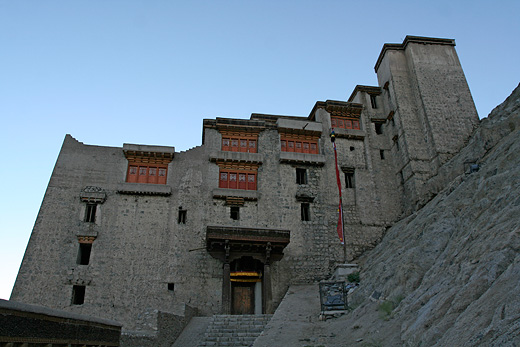
Old Castle and Namgyal Tsemo Gompa. The two structures are adjacent to each other on a tall hill, and are visible from anywhere in the town. They were built by Tashi Namgyal, the king of Ladakh three generations before Sengge Namgyal. The castle is a small building, and is closed for visitors. The gompa (Buddhist monastery) doesn’t have any lamas living and studying there. A monk from Sankar Gompa comes here every morning to perform daily puja.
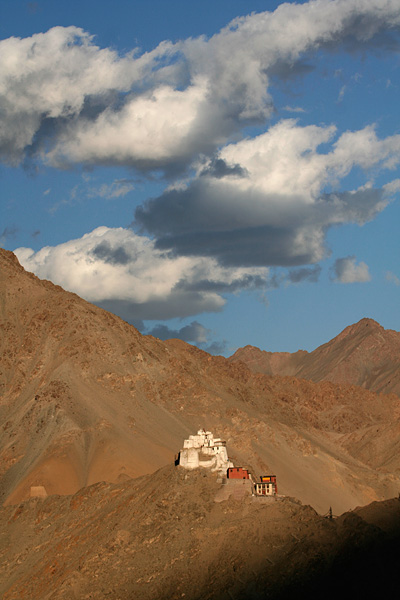
Shanti Stupa. This is a relatively new structure built on a hill on the side of the town opposite to Namgyal Tsemo. It is a good place to spend an evening looking down at Leh town and the Indus Valley, and to watch sunset over the mountains.
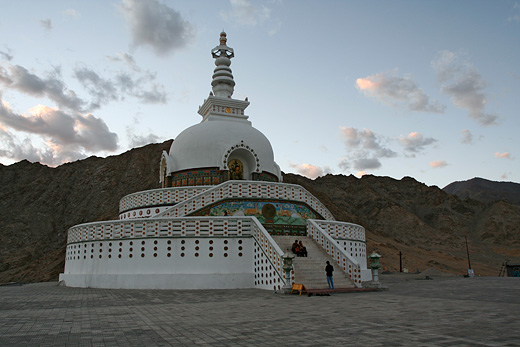
Soma Gompa. Soma Gompa is one of the newer monasteries in town. The prayer hall here lacks the rich decorations seen in older monasteries in rest of Ladakh. Visit the monastery to watch the gathering of monks for early morning prayers.
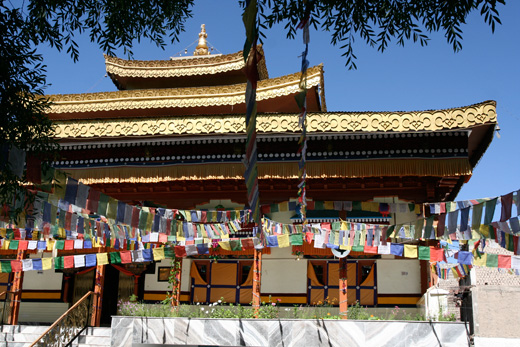
Sankar Gompa. A 15-minute walk from the main market is Sankar Gompa, located in the quiet village of Sankar. The monastery is open to visitors only for a few hours in the morning and evening. Get to know the timings before you go.
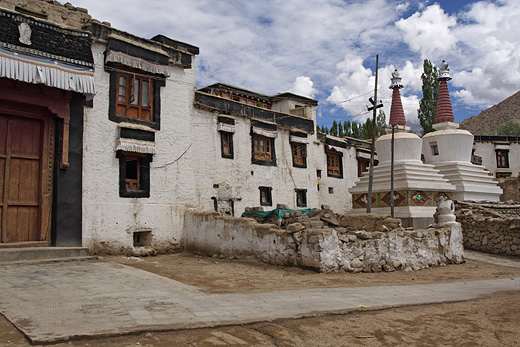
MORE INFORMATION
The town is centered around the main market, a small road where tourist amenities can be found. Most travel agents in Leh are located here, and can help you with your travels in Ladakh. If you are planning to go on a trek or jeep ride to any of the tourist destinations (like Pangong, Nubra, Tso Moriri), but can’t afford to hire a jeep on your own, you can register with one of the agents who might bundle a few more tourists with you to spread the cost. You will see signs posted in front travel agents offices about planned schedule of treks and tours for which they need more people.
Most upmarket hotels are located on Fort Road, which begins from one end of the market. Budget guesthouses can be found in changspa (or chanspa). If you prefer a quiet place with no traffic, noise or people, look for accommodation in Sankar Village. It is far from the main market compared to Fort Road or Changspa, so you would be better off there only if you are staying for a longer duration.
Ladakhi Food is hard to come by anywhere in Leh. Restaurants in the market serve Indian, Italian, Israeli and continental food and little else. If you are looking for something Ladakhi, try the cafe at Women’s Alliance on Sankar Road. Their preparations are not entirely authentic local cuisine, but they try. If you walk on a narrow lane next to SBI on the main market, you can buy freshly prepared Ladakhi Bread.
A compassionate grandmonther who spoke to us caringly and made us feel at home, an old man who alway s wore goncha – the traditionally Ladakhi wear, a young man who was always available for help and a cute little girl who melted our hearts with her broken-tooth smile. Together, they formed the family that hosted us in Leh. We randomly picked our accommodation in the town, and ended up lucky to stumble upon this friendly bunch who ran a guesthouse.
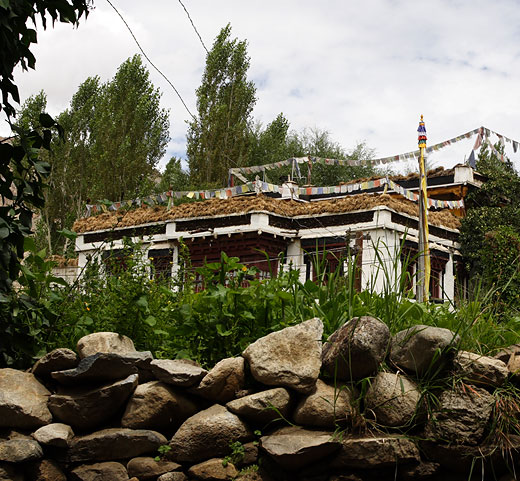
The guesthouse at Leh
It was a simple place managed by a young man named Wangyal, a small guesthouse with a bunch of rooms built next to their residence. The one-acre enclosure had a few apple trees and a vegetable garden where they grew at least a dozen things. We had arrived there in darkness and had immediately crashed for the night after the long journey from Keylong. Waking up late next morning, I peered through the window and saw Namgyal Tsemo Gompa through a small gap between apple trees. Some branches of an apple tree brushed into the wall near the window. The tree was full with fruits, but unfortunately unripe.
The guesthouse was in a quiet place far from the market, in Sankar Village. No vehicles, no noise of any sort and no commercial activity whatsoever near by. The hours of the day spent in the guesthouse would go quiety, reading a book, having breakfast under the apple trees or over a social dinner at the beautifully decorated dining hall.
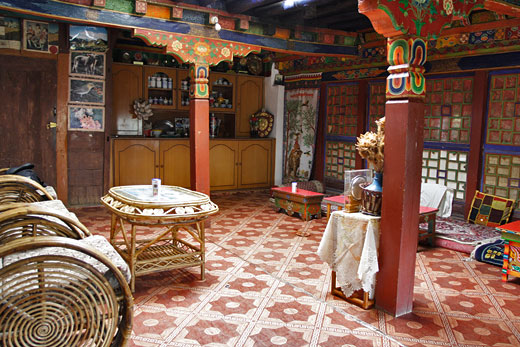
The dining room
Wangyal appeared stern when he spoke, but was a friendly and helpful man. On the first morning when we needed to find our way to the market, he accompanied us half the way and showed us the route through a maze of narrow passages. When we checked out after 10-days without paying him because we were in a hurry and could not find him on time, he was not upset about it. Of course, we cleared our dues a week later after returning to Leh.
The little kid was someone whom I looked forward to see all the time. She always had an easygoing, charming smile on her face. She would come play with us ,and say a few things slowly in her broken tongue. And the grandmother was always there, sitting and watching from her chair and pretending anger when the kid was naughty.
Sometimes the grandmother and kid would spend hours together working in the garden. So many veggies and flowers grew in the garden that I never managed to count them all. There were cauliflowers, onions, sweet peas, some edible leaves, at least another half-a-dozen vegetables and an uncountable variety of flowers. I wanted to spend an hour or two checking them all out, but it never happened.
The guesthouse was a great place to stay, but there was a small problem to take care of. I had to go to the main market for everything – to see places in the town, to have lunch, to talk to travel agents and for any other transactions. The market was a little far, and walking back and forth was a pain. The bus-stop was even farther, and meant long walks through the town when I did short day-trips out of Leh. In the later days when I stayed in Leh on transit, I ended up staying at another guesthouse closer to the town. But the old place always remained the favourite.
Sengge Namgyal must have been a proud king when he moved into the new palace in Leh. There was probably no other structure anywhere in the kingdom of Ladakh that matched the edifice overlooking the old town of Leh. Travellers of those times praised it to no end, and called it second only to the giant Potala Palace in Lhasa.
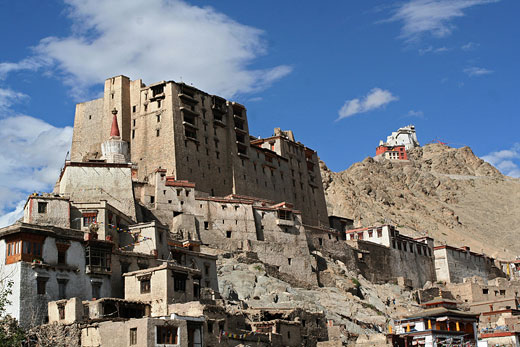
Leh Palace with Namgyal Tsemo Gompa and Tsemo Castle in the background
Everything must have been going well for Sengge. Not long after succeeding his father to become the king of Ladakh, he had conquered parts of vast Tibetan Plateau adjoining his kingdom to the west. Trade flourished in many directions – along the famed silk route to the north, with Kashmir to the west, and with Tibet to the east. His coffers were full. There were some bitter and unsuccessful conflicts with the Muslim rulers of Kashmir, but that did not affect the kingdom much. There was no reason not to splurge on a palatial structure that would dominate Leh’s landscape for next four hundred years. He so ordered for the nine-storey palace to be built on a hill just above the old town. For the royal residence, it was a remarkable improvement. The palace was more than ten times larger than the old castle built by his great grandfather.
Although there are no clear records, the palace could be dated to first half of seventeenth century, a few years before Sengge’s death in 1642. Today, it may not impress travellers coming from far away in terms of size (if you put all the marketing aside), but still remains one of the biggest structures in Leh. The mushrooming hotels in the northern part of the town are getting bigger and bigger and someone may build a hotel larger than the palace one day, but there is none so far.
I woke up before the crack of dawn one morning and walked through the maze of lanes in the old town to get to the palace. From its elevation, I could see the first light of dawn chasing away the shadow of the night and descending through the peaks of Zanskar Ranges, down to Indus Valley and then to Leh Town. The town was sleeping, but the peaceful morning was broken by the muezzin’s call for morning prayers, and later by reverberation of ‘Om Mani Padam’ from Soma Gompa.
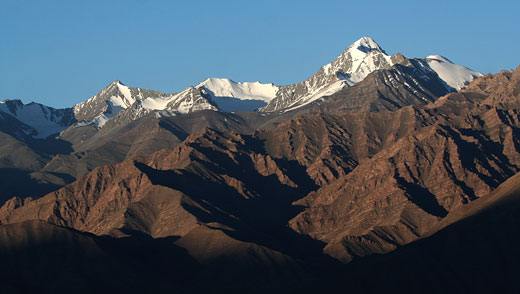
First light on Stok Kangri Peak and other mountains of Zanskar Range
My guidebook indicated that the palace is open from sunrise to sunset, like any other ASI monument. It was confirmed by a sign in front of the ticketing booth at the palace, but the booth was closed and so were the doors of the palace. I must have waited there till about 8am hoping for someone to come and open up. Thankfully the mountain vistas kept me busy during the hour of sunrise, and was later entertained by a monk who struggled for 30-minutes to kick-start his bike. Just when I was about to give up, the doors opened from inside and a sleepy-eyed man walked out. He seemed to be a worker involved in palace restoration, and must have decided to use king’s quarters to live in while he worked there. He left the door ajar and let me walk in and explore on my own.
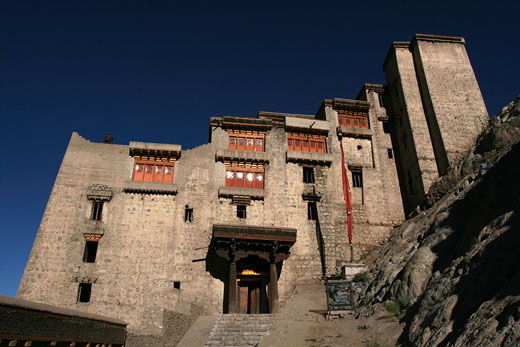
Leh Palace.
The insides of the palace were completely empty. There were no plush carpeted interiors, generous decorations and furnishing that one would look forward to see in a palace. Dark walls welcomed me in all directions, with a shaft of light appearing from one of the corners. An incandescent bulb burned somewhere ahead, letting me find my way into the heart of the palace. Along with the musty smell of oldness was a odour of restoration activity, of freshly cut wood and varnish. The palace was being spruced up by Archeological Survey of India, and there was little to see inside when I went. All that was a maze of empty rooms where I got lost several times. But up from the terrace of the palace, I was awed by the Ladakhi vistas that had impressed me all through the journey to Leh. The mountain peaks, brown slopes, the Indus River are all there to see, uninterrupted.
My meditation on the mountains was interrupted by the call of a Bactrian Magpie that sat on a perch and announced itself incessantly. Descending from the terrace, I made the slow climb further up the hill to the old castle and Namgyal Tsemo Gompa. The castle and the monastery were built by Tashi Namgyal, Sengge’s great grandfather. They are small and barely make a mark but for their location high up on a peak. It is surprising that these structures of mud and stone have weathered five hundred years and remained fairly intact. A sign near the door said ‘Tsemo Castle’, and its doors were locked up. A lone monk performed the morning puja in the monastery, where I did not spend much time inside.
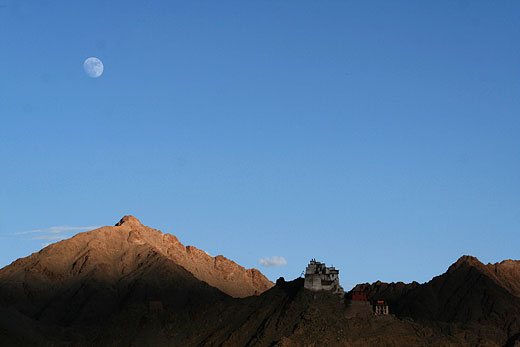
The red structure in the middle is Namgyal Tsemo Gompa. The dominating white building is Tsemo Castle
The castle was closed, but the painful climb up through a steep slope in the thin mountain air was not a waster. Wherever you are in Ladakh, climbing higher always means better views, and this was no exception.
Down the hill and into the town, I went in search of the place where I heard the chanting from the monks. Morning puja was on at Soma Gompa in the middle of the main market. Monks sat in rows and recited what sounded like continuous murmur to someone who doesn’t understand the language. The exercise was coupled with a lot of action, as they touched their nose and ears with fingers and made signs with their hands. The prayers lasted long enough that they had breaks for tea and snacks. Sitting in a corner and watching the performance, I also got my first taste of Yak Butter Tea, or gur-gur as they locally call. It is made of barley flour and salt with a generous portion of butter floating on the top. Gur-gur is not something that the tourists take a liking to, but I found it very much drinkable.
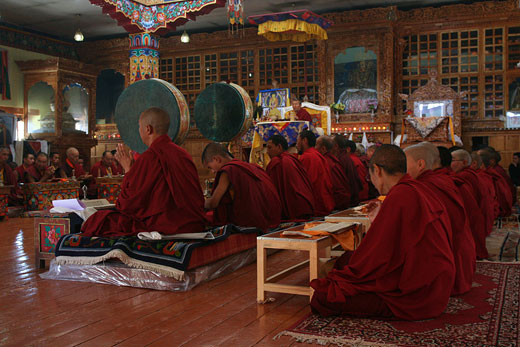
Inside Soma Gompa
Walking out of Soma Gompa and along the market, I kept looking back at the Leh Palace – the dominating building in this part of the town. I remembered expecting to find something typical to what a palace should have inside when I walked in – like plush interiors, a hall that formed king’s court, sections to seat officials at work, an area for women, king’s private quarters and so on. The Palace probably had all that, but its dark passages and the under-renovation interiors hid them away from me. I shall come back again some day when it is less challenging inside!











